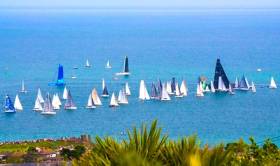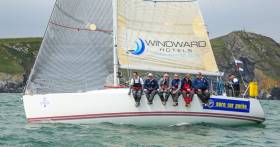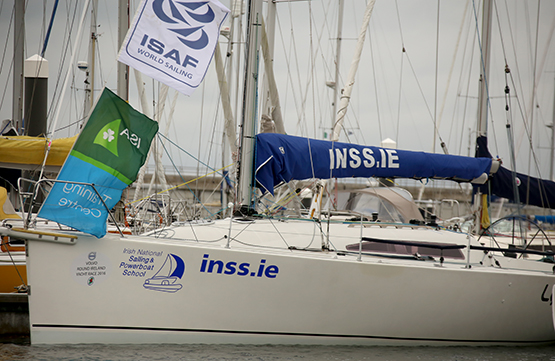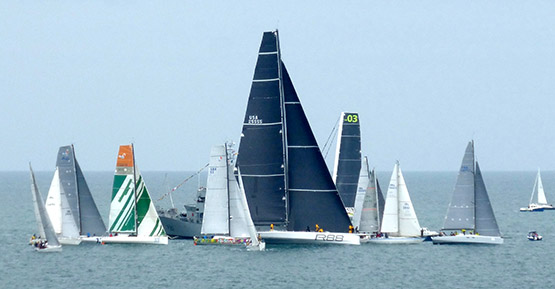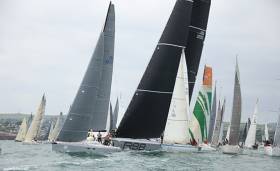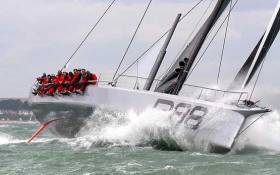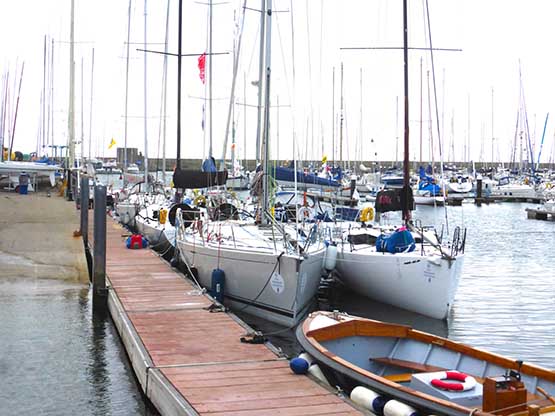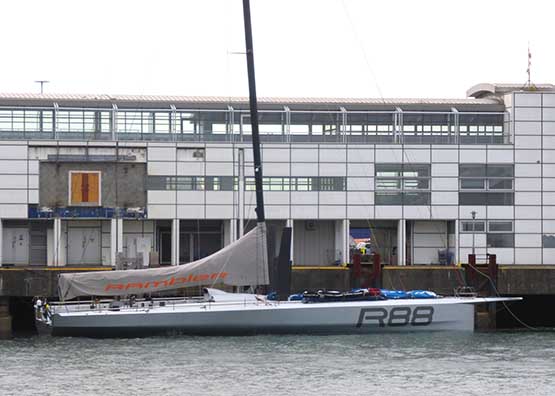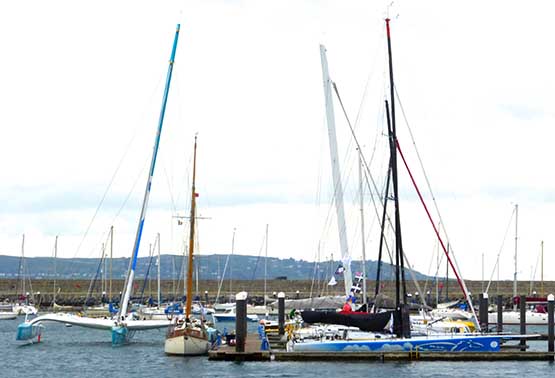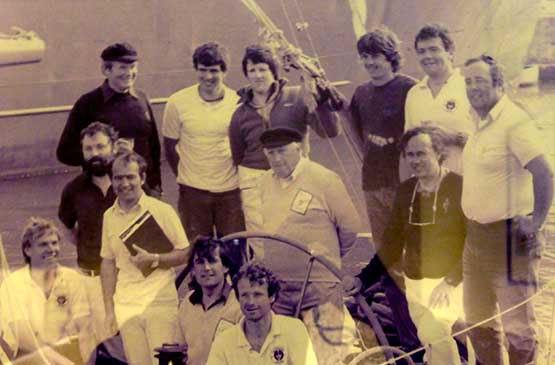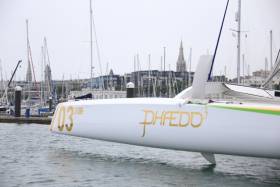Displaying items by tag: Round Ireland Yacht Race
Wicklow Sailing Club are best-known as the big-hearted little organisation which keeps the iconic Volvo Round Ireland Race show on the road with such style that it is now one of Europe’s premier events, with a stellar international entry list of 63 boats – many of them world famous - in June 2016. But where some other smaller clubs might find their own members’ sailing activities distorted or diminished through the voluntary organisational effort which is required to keep a biennial mega-event on this scale running smoothly, in Wicklow the reverse is true writes W M Nixon.
The big race – at 704 miles it is nearly a hundred miles longer than the other classics such as the Fastnet, the Sydney-Hobart, the Caribbean 600, the Bermuda Race and the Middle Sea Race – is run with the full co-operation of the RORC, and back-up support from the Royal Irish YC in Dun Laoghaire. Yet in Wicklow the club spirit is such that not only are there volunteers ready and willing to provide further assistance to key personnel such as the Volvo Round Ireland Race Organiser Theo Phelan and his team, but there is ample evidence that this high level of voluntary effort spreads into every corner of club activity. This is particularly the case with a thriving junior training and racing programme, in which the leading figures have been Dave Ballesty and Mark Redmond.

 Wicklow in a different mood, as it might be seen while cruising, with a couple of visiting yachts in port including a pretty little schooner, and the Wicklow SC junior training squad heading back towards the club after a day’s instruction afloat. Photo Mike Harper
Wicklow in a different mood, as it might be seen while cruising, with a couple of visiting yachts in port including a pretty little schooner, and the Wicklow SC junior training squad heading back towards the club after a day’s instruction afloat. Photo Mike Harper

Anyone who has been in Wicklow for the impressive, crowded and colourful Seafest which is clustered around the Volvo Round Ireland Race start at the midsummer weekend will have naturally tended to assume that, after the big event has been tidied up and its week of long-distance racing rounded out with the Friday night prize-giving, Wicklow sailing takes a well-earned rest.
Not so. The Round Ireland tents are folded away, and the real Wicklow, la Wicklow profonde, will have emerged within days. Toppers, Lasers, Picos and other two-handed dinghies will flock seaward for training, accompanied by busy instructor RIBS zooming about to encourage yet another new generation into proper sailing in a club which has produced notable sailors on the national and international scene such as Round Britain and Ireland two-Handed winner Brian Flahive, Commandant Barry Byrne the winning Skipper of the inaugural Beaufort Cup at Volvo Cork Week in 2016, award-winning international cruising man Alan Rountree who self-built – to an immaculate level – his much-travelled 34ft sloop Tallulah, and the popular Charlie Kavanagh, whose abilities as a seaman and sailing teacher are deservedly renowned.
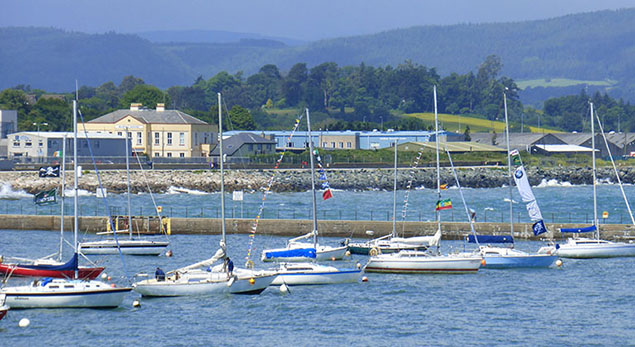
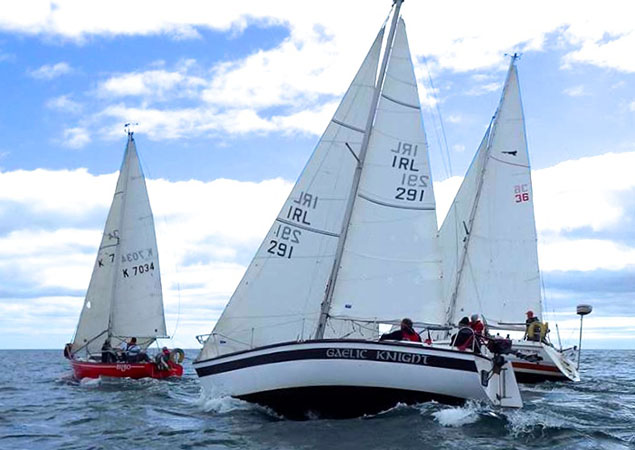 Wicklow cruisers in action for a club race, WSC has produced several sailors of national renown
Wicklow cruisers in action for a club race, WSC has produced several sailors of national renown
But being Wicklow, these kids coming up through a club which has been producing distinguished sailors since its foundation in 1950 will have voluntarism in their genes. Wicklow SC has only around 160 members, of whom barely a hundred are full adult members. Yet not only most of the adults, but many of the young people too, see voluntary work for the club - both in keeping its activities at a high level while maintaining its fabric and the fleet of club-owned training boats in proper order – as part of the Wicklow way of doing things. And of course among all sailing folk, whether racing or cruising, dinghy or offshore, Wicklow Sailing Club is a byword for hospitality and making newcomers welcome to our sport.
 Getting them started. Guidance and instruction from Dave Ballesty for a group of junior trainees.
Getting them started. Guidance and instruction from Dave Ballesty for a group of junior trainees.
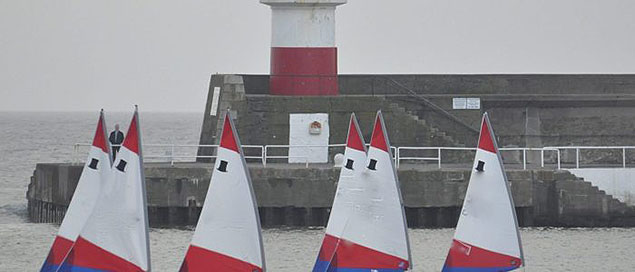 An unexpected bit of colour co-ordination for Wicklow’s famous lighthouse and the local Topper fleet
An unexpected bit of colour co-ordination for Wicklow’s famous lighthouse and the local Topper fleet
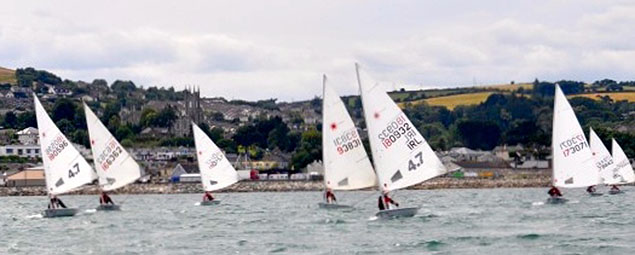 Lasers racing at Wicklow over the same waters where the Volvo Round Ireland start is staged, and where the finish is fought out
Lasers racing at Wicklow over the same waters where the Volvo Round Ireland start is staged, and where the finish is fought out
 Wicklow Harbour seen from the southeast. It takes ingenuity and dedication to run a successful sailing club in what is essentially a busy small commercial port
Wicklow Harbour seen from the southeast. It takes ingenuity and dedication to run a successful sailing club in what is essentially a busy small commercial port
With a thriving club life, it also plays a key role in its local community. Yet at the same time, every two years since 1980 it has organised the Round Ireland Race. And though there have been years when the entry has been thin enough, in 2016 everything came together with glorious success for a club which simply never gave up on the idea that a proper Round Ireland Race was central to the entire Irish sailing scene.
To say that the race organisers down the years since 1980 have beavered away behind the scenes to keep the show on the road only hints at the effort sometimes required to enable an event of this stature to fulfill its true potential. But since 2012, current organizer Theo Phelan has been working with a special statesmanlike dedication – some would call it Machiavellian skill – to raise the event onto a new plane. By 2016, with the full support of the RORC and its Irish Commodore Michael Boyd, together with the discreet assistance of the Royal Irish Yacht Club in Dun Laoghaire in order to provide a pre-race base for larger yachts, and the added involvement of superstar multi-hulls to make full use of a package which now included sponsorship from Volvo Car Ireland, the Round Ireland Race came of age and entered the big boys league.
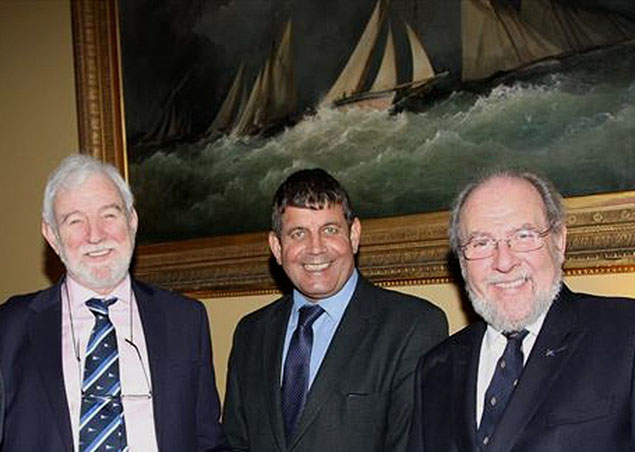 Spreading the support base. Round Ireland Race organiser Theo Phelan (left) with Wicklow TD Andrew Doyle, and Jim Horan, Commodore of the Royal Irish Yacht Club
Spreading the support base. Round Ireland Race organiser Theo Phelan (left) with Wicklow TD Andrew Doyle, and Jim Horan, Commodore of the Royal Irish Yacht Club
Yet this all was done from one tiny club in a workaday commercial and country town whose small port has a very strong commercial bias. But when something is functioning as perfectly as Wicklow Sailing Club and the Volvo Round Ireland Race in 2016, perhaps it’s better not to dissect it all in too much detail. You might break the magic spell. So instead, we’ll just try and tell you who does what, and hope the story speaks for itself.
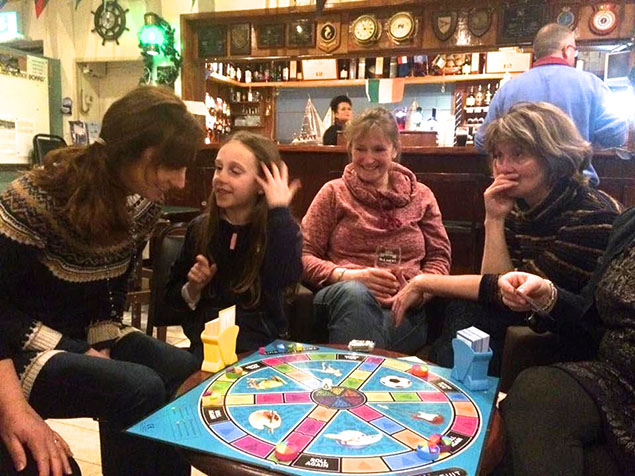 In addition to its major role in sailing, Wicklow SC is very much a community focus with an emphasis on family life – this is a Games Night for all ages in the Clubhouse
In addition to its major role in sailing, Wicklow SC is very much a community focus with an emphasis on family life – this is a Games Night for all ages in the Clubhouse
Wicklow Sailing Club has learned to live with the biennial appearance of the big one by ensuring that the Commodore’s two year term sees that the Round Ireland Race – which has to be in a non-Fastnet year – will be happening in the second year of office, when he or she is well settled into the top role. But even this was something which had to be learned, and the club is eternally grateful to a former Commodore Johnny Johnson, who gallantly served three years in order to get the sequence right.

 Round Britain & Ireland Two-handed Winners Liam Coyne & Brian Flahive were conferred with Honorary Membership of Wicklow SC – (left to right) Liam Coyne, WSC Commodore Hal Fitzgerald, President Sadie Phelan, and Brian Flahive.
Round Britain & Ireland Two-handed Winners Liam Coyne & Brian Flahive were conferred with Honorary Membership of Wicklow SC – (left to right) Liam Coyne, WSC Commodore Hal Fitzgerald, President Sadie Phelan, and Brian Flahive.
However, when you’re drawing on such a small membership, the succession has to be carefully planned to make best use of the limited pool of talent, and when Wicklow Sailing Club’s officer and committee board underwent its usual total biennial change just ten days ago, Hal Fitzgerald stood down after his two year term as Commodore to be succeeded by Denise Cummins, who had been Honorary Secretary and thus will be tuned to every nuance of club life and administration when the Volvo Round Ireland Race 2018 comes roaring over the horizon.
Last year’s full list gives an idea of the many talents needed to keep any club operating smoothly:
Wicklow Sailing Club - 2016
Officers, General Committee and Sub-committees
President: Sadie Phelan
Commodore: Hal Fitzgerald
Vice-Commodore: Brian Malone (Lead for Try Sailing - Cruisers)
Rear Commodore Sailing: David Ryan (lead for Berthing Round Ireland)
Rear Commodore House: Gerry Nolan (Long standing, long serving member, came to cruisers after many years on the GP 14 circuit)
Hon. Treasurer: Fergus Somers (Lead for Finance Ctte)
Hon. Secretary: Denise Cummins
Membership Secretary: Joanne Logan (& Finance Ctte)
General Committee:
Dave Ballesty (ISA Training Centre Principal, Try Sailing – Dinghies, & lots of other work), Eugene Lynch (Communications & VRIYR Official Race Programme), Roisin Hennessy (Lead for Dinghies), Paul Hennessy, Kyran O Grady (Lead for boat maintenance & house fabric), Peter Shearer, Angela Higgins (Ballesy) (Lead for Grants & Club Development).
Volvo Round Ireland Yacht Race Organising Committee:
Chair & Secretary: Peter Shearer
Race Organiser: Theo Phelan
Asst Race Organiser: David Ryan
Commodore ex officio: Hal Fitzgerald
Volvo Round Ireland Yacht Race Catering Committee:
Sandra Fitzgerald, Liam Whitty, Paul Hennessy PLUS many, many volunteers, particularly those who fed the returning boats.
ISA Training Centre Principal: Dave Ballesty, assisted by Mark Redmond and Roisin Hennessy
However, in a club of this size it would be very counter-productive if people insisted on a clear job description, and stuck rigidly to their own interpretation of the brief. A delicate balance has to be drawn and maintained between recognizing who is ultimately responsible for some task, yet being prepared to leap in to do the job or at least assist with it during periods of particular stress.
And of course in a town like Wicklow – which mercifully is just far enough from Dublin to be its own place, healthily clear of rigid metropolitan attitudes – there’s interest in how people spend their time in their day jobs, and the lineup keeping the Wicklow SC machine moving along includes the talents of one of Ireland’s leading thatchers, Kyran O’Grady, who in 2017 takes on the additional role of Honorary Treasurer, whole another key figure is David “Farmer” Ryan who organised the participation of the Volvo 70 Monster Project in the 2014 Race, and is getting his sailing off to an early start this year with participation in the RORC Caribbean 600 in February.
As for the season of 2016, everyone will be well aware that in the Volvo Round Ireland Race for mono-hulls, the overall winner, line honours winner and establisher of a new record was George David with Rambler 88, while the multihull winner – by a matter of seconds – was Oman Sailing (Sydney Gavignet), which also established a new record.
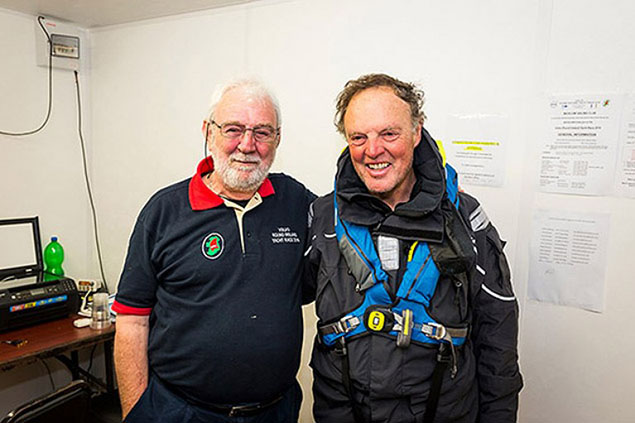 Theo Phelan and RORC Commodore Michael Boyd immediately after the latter had taken third place overall in the Volvo Round Ireland Race 2016.
Theo Phelan and RORC Commodore Michael Boyd immediately after the latter had taken third place overall in the Volvo Round Ireland Race 2016.
But for aficionados, perhaps the most popular prize was what might be called the Corinthian Award, which doesn’t actually exist, but if it did who would have gone to RORC Commodore Michael Boyd who took third overall in the standard First 44.7 Lisa after sailing a virtually faultless race, a race which incidentally he won overall in 1996, racing the J/35 Big Ears.
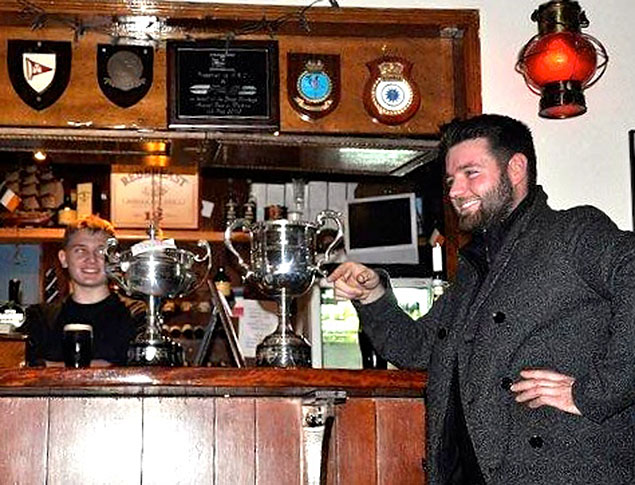 Jason Moran with his 2016 club trophies won with his Hydro 20 Hydrogin
Jason Moran with his 2016 club trophies won with his Hydro 20 Hydrogin
Once it was all over, Wicklow life resumed, and local racing saw Jason Moran with the David Thomas-designed Hyrdo 28 Hydrogin win the cruiser classes, while the dinghy events were dominated by the annual Junior Regatta which produced a wide spread of results, and here’s a photo of the winners:
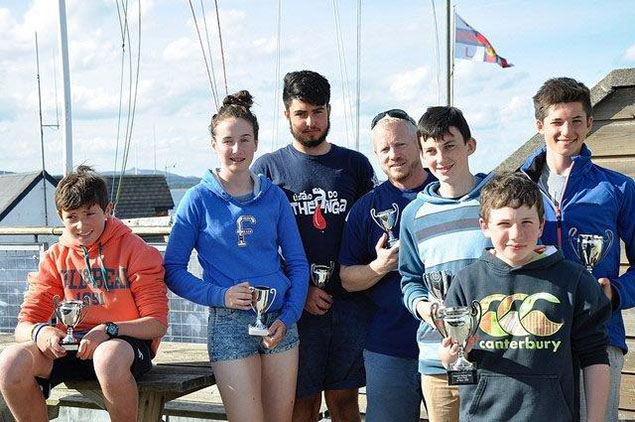 Winners at the 2016 WSC Junior Regatta were (alphabetically) Cillian Ballesty. James Beattie Doyle, Ryan Fitzgerald, Charles Heather, Rick Johnson, Isobel O’Grady, and “a visitor from Courtown Sailing Club”.
Winners at the 2016 WSC Junior Regatta were (alphabetically) Cillian Ballesty. James Beattie Doyle, Ryan Fitzgerald, Charles Heather, Rick Johnson, Isobel O’Grady, and “a visitor from Courtown Sailing Club”.
Wicklow Sailing Club last won the “Club of the Year” award in 1979. In those pre-Round Ireland days, they were experimenting with events which would make sailing more accessible, and Irish ports more welcoming, to sailors from elsewhere. So they staged a sort of cruising rally open to absolutely everything which floated, and from anywhere, and it worked very well to be the highlight of a busy season for a club which was starting to find its feet.
They’ve certainly found their feet very well indeed now. The entire Irish sailing community owes a mountain of gratitude to Wicklow Sailing Club for never losing the faith on the Round Ireland race, and bringing it to its present eminence through sheer dogged persistence, and an awesome amount of hard work, nearly all of it voluntary. They become the very worthy Mitsubishi Motors “Sailing Club of the Year” 2017.
 It is not generally known that Wicklow is in a unique micro-climate where sub-tropical conditions are frequently experienced, and Junior Instructors have to take special steps to protect themselves from the sun’s rays.
It is not generally known that Wicklow is in a unique micro-climate where sub-tropical conditions are frequently experienced, and Junior Instructors have to take special steps to protect themselves from the sun’s rays.
Dave Cullen Is Afloat.ie 'Sailor Of The Month' For June
While the Volvo Round Ireland Race 2016 was the most international ever seen, some of the keenest racing was among the Irish boats in a fleet of such quality that just to secure a class win was to have made an outstanding achievement.
In the end, while there were many Irish boats which were there or thereabouts in their respective classes, there was only one class winner from Ireland. And that was Dave Cullen of Howth racing the chartered J/109 Euro Car Parks.
Although he has raced round Ireland in a Half Tonner in times past, the enthusiastic Cullen reckoned that for today’s fleets, a J/109 offers a better proposition. So he left his lavishly-maintained Half Tonner Checkmate at home, and put his usual eclectic crew of all the talents aboard the chartered J/109 which became Euro Car Parks.
Yet despite the very evident sponsorship, this was by no means a “no expenses spared” campaign. It was run on a tight budget, and it relied on the talents of such as Mark Mansfield and Maurice “Prof” O’Connell in the crew to bring the boat home on time.
And it was a mighty test of character. They weren’t well placed passing the Tuskar, but in the harsh slug along the south coast, Euro Car Parks crew sailed like men possessed, and by the time they were approaching the Fastnet, all the other J/109s were nowhere, relatively speaking.
But there were many other boats in the fleet and in Class 3 to give them a hard time, and the second setback came off the mouth of Bantry Bay early on the Monday morning. The good winds had moved a few miles further north, and Euro Car Parks found herself headed inside Dursey Head, requiring a painful beat in a lumpy sea to get back on track.
By that time their most significant class rival, Paul O’Higgins’ new higher-rated JPK 10.80 Rockabill VI, was making such good progress up the west coast that she rounded Tory Island forty miles ahead of Euro Car Parks. Yet the Cullen crew never slackened the pace, and when a localized calm at Inishtrahull stopped Rockabill VI for an excruciating three hours, the J/109 kept up the pressure, going from being far astern to relatively close astern by the time Rockabill got going again.
For the smaller craft, the rest of the race was torture, as the big winds which had sent the leaders and larger craft round at such speed were now fading, and the final agony was a period of calm eastward of Drogheda on the Wednesday evening. Yet they kept going, they were in the hunt and at the finish for Class 3 on IRC it was Euro Car Parks first, Rockabill VI second, and Conor Fogerty’s Sunfast 3600 Bam! third, making Dave Cullen our Afloat.ie Sailor of the Month for June 2016.
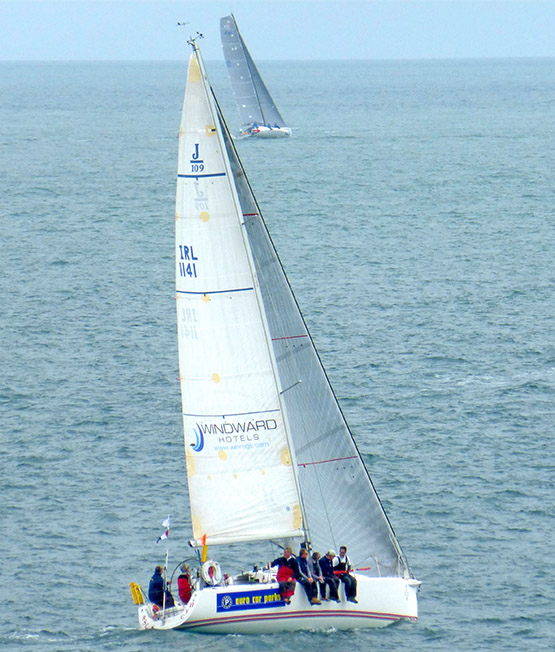
Irish National Sailing School's Lynx is First School Boat in Round Ireland Yacht Race
INSS School principal and skipper Kenneth Rumball reviews his tenth place overall in Volvo Round Ireland 2016 on board the INSS Reflex 38, Lynx.
The idea for the Irish National Sailing & Powerboat School to compete in the Round Ireland Yacht race was hatched even before the company planned to enter into the yachtmaster business. In fact when selecting a yacht for our competent crew, dayskipper and yachtmaster teaching duties, we made sure to select a boat that could not only fulfil our teaching duties but could look after an amateur crew while also competing at the highest level offshore.
Our Reflex 38 spent her first year primarily away from racing duties before undergoing significant race preparation ahead of this year’s Round Ireland Yacht Race. Our hull was stripped back and freshly antifouled, electronics upgraded, sheets and halyards replaced along will a full sail valet and re-measurement, this all topped off with a full IRC re-measurement in an effort to reduce our TCC ahead of the race.
Meanwhile we started to advertise our campaign for the year ahead which included not only the race but 2 dedicated training weekends along with 4 ISORA training races to ensure our crew was fully prepared along with the boat ahead of this year’s race. Lynx performed well in this training races, coming 4th in the Dun Laoghaire to Holyhead and 5th in the Dun Laoghaire to Isle of Man.
All set for the off – the INSS Reflex 38 in Dun Laoghaire
All set, our crew for the Round Ireland left Greystones Marina on the 18th of June for the race we had been preparing for all year. Keeping our noses clean at the start, we got clear early and made big gains by going close in under Wicklow head to be one of the first boats heading south. Pulling nicely in the first two hours, unfortunately we got stuffed in a no wind hole off Arklow. Going again we made good ground to round Tuskar in the leading pack before heading south into the building breeze. The breeze built and built and in changing down through our sails we unfortunately blew out or number 4 jib, eventually bringing us down to storm jib and two reefs in the mainsail, below is one our crew’s recollection at this time;
“I’ve never done a long offshore race before. In fact I only started sailing in April this year, so to say I was out of my depth on the Round Ireland is an understatement. However, I was somewhat cautious and logical, so I completed a few courses with INSS on the run up to the to the race including Sea Survival. During this course, among other things, I briefly learned about a storm jib and trysail. I was told I would probably never need to use this type of sail, but it was good to know. Come Sunday night off Cork, day 2 of the Round Ireland, the breeze picked up and I watched our torn number 4 headsail being bundled down the companion way with a calm call for the storm jib. Jaaaysus, I thought, storm sails, storm sails? What's next? What was the next module on that course? I think it was boarding a life raft...”
Once we got around the Fastnet, we were able to crack sails for a great yacht up the west coast, it got a bit breezy at one point where we blew out our A5 in about 35kts of breeze off Galway which forced us to move to our S3. With the clearing weather, we had a great sail around Tory Island while we calculated our approach to the notorious tides around Rathlin Island. Much to our surprise, we hadn’t done a good job of getting to Rathlin on time, we had in fact NAILED our timing, giving us a great run down toward Belfast Lough.
In good breeze we continued on a beat down the Irish Sea before being becalmed in Dundalk Bay. Here we struggled on the last night to get into the land breeze where unfortunately some of the lead boats got away… We spent most of the last night drifting trying to sniff any breeze out with the code zero. It wasn’t until the next morning off the Baily that we got going again to sail in good breeze into Wicklow.
Lynx finished after 5 days and 49 minutes in the 2016 Round Ireland, coming 4th in class 3, 10th overall and 1st Sailing School boat! It was a fantastic race where I am ever grateful to the crew who for some it was the longest they had ever spent at sea and who all performed admirably throughout the race, they would be a real asset to any offshore campaign in the future. Special thanks also go to Conor Kinsella and Luke Malcolm whom I really would have struggled without their talent and dedication.
See Round Ireland tracker here Afloat's Round Ireland 2016 coverage is here and download overall results here
At 704 miles long, with a course along coastlines of almost infinite variety, the Round Ireland Race was always a complex event for post-race analysis even when fleets amounted to only three dozen or so. But for 2016 in the first year of sponsorship by Volvo Car Ireland, the number of starters soared to 63. And the inclusion of multi-hulls for the first time since the initial pre-RORC race of 1980 added further depth to the eclectic nature of the fleet, which was already an extensive array, as it ranged from small craft like a J/97, a First 31.7 and a Sunfast 3200, to one of the current superstars of world sailing, George David’s Juan K-designed canting-keeled Rambler 88. Having provided us with 17 up-dates during the six days of the race, W M Nixon takes a final overview.
Here’s to Yellowbrick, the friend of armchair sailors everywhere. In the old days, trying to analyse or explain the unfolding story of the biennial Round Ireland Race was a formidable challenge. And you could be talking about it to people very few of whom had ever sailed round Ireland, while others didn’t even know it from the land, as they have been availing of sunshine holidays ever since cheap air travel arrived.
Thus there are many who know more of the coasts of Spain, Portugal and Greece – or even the Scottish Hebrides and the Isles of Scilly - than they do of Mayo and Donegal. And having experienced both those Irish counties in their more perverse meteorological moods in the course of several races round Ireland - not to mention many non-racing cruising circuits – I have to admit that I can see their point of view.
The Yellowbrick tracker for the Volvo Round Ireland Race 2016 wraps Ireland in its web. TriLogic went furthest east after the start, the three MOD 70s went furthest south off the south coast and furthest west off the west coast, Rambler 88 went furthest northwest, and Pegasus of Northumberland went to the Isle of Man but came back to cross tacks yet again with Teasing Machine, this time at Skerries as the Machine came south from Dundalk Bay.
"Round Ireland 2016 is in a special league of its own"
Yet the round Ireland race is addictive, and for those who have done it in the past, particularly those who have done it several times, it’s a bit of a pang to see the fleet go off and not be part of it. Even with all the modern equipment and boats which are obviously faster, it’s still a very worthy challenge. And it induces a special post-race camaraderie among crews who, in racing terms, have been at each other’s throats since the start.
After each biennial staging, something new has always turned up to add to the sailing history books. But the Volvo Round Ireland Race 2016 is in a special league of its own in this category, so much so that far from just adding something to the history books, it probably deserves a book of its own.
In fact, you could write a book about the fantastic start in which Rambler 88 gave a Masterclass in discerning emerging gaps beginning to appear in a melee of sometimes confused smaller bats. Despite her huge beam she came cleanly through to a peach of a start right on the committee vessel LE Aisling, bettered only by Eric de Turckheim’s A13 Teasing Machine while smaller craft which thought they’d done better found they’d been OCS, which led to a slow and painful return against a strengthening ebb to re-start.
Rambler’s miraculous start, finding gaps where none had existed ten seconds earlier. Photo: W M Nixon
Fortunately in making some sense of what happened afterwards, we can take a precise positional overview by looking at the Yellowbrick tracking as it was at virtual completion yesterday afternoon. It may look like a right cat’s cradle of lines all eventually getting back to Wicklow, but there are stories to be drawn from every part of it.
In the first beat from Wicklow Head down to the Tuskar Rock, very few boats tended to the east, and it certainly didn’t pay off. The one who went furthest east was the 50ft Trilogic, Hugo Carlsson-Smythe’s trimaran, which ultimately retired during the course of the race with gear and sail problem, so we don’t know if ultimately she would have overcome this initial tactical error.
The mono-hull which tacked furthest east was Chris & Patanne Power Smith’s J/122 Aurelia (RStGYC), but she then put in a good showing in the long beat along the south coast and got herself back in the hunt, although off the north and east coasts things didn’t go quite so well, but in the end she placed 3rd in IRC 2 and 18th in IRC overall.
"Teasing Machine made a proper job of tide-dodging"
While the bulk of the fleet were still struggling against foul tides down the Wexford coast with Teasing Machine showing how to make a proper job of tide-dodging inside the Wexford banks, out ahead the biggies were splitting into their two parts of this fleet of four parts.
Although the reckoning was that conditions might just fall the right way for a new record, the three MOD 70s first had to find a breeze to raise them above the 12 knots which they occasionally fell back to as they came on starboard out past the Coningbeg Light. Thus it’s Musandam-Oman, Phaedo and Concise which are those three tracks which go way to the south. As they were so close to each other in performance, they sailed as a pack, so there was an element of covering as much as strategy in this, but in these early stages it was Ned Colllier Wakefield aboard Concise who was making the pace, with Phaedo next in line, while Musandam seemed to find it difficult to obtain quite the same speed.

The first hint of light in the east in the sky as the MOD 70 Musandam-Oman closes in on the Wicklow finish for a last-minute takeover of the line honours lead on the water, after her sister-ship Team Concise had led for most of the race. Photo: Mark Lloyd
Perhaps Irish sailing superstar Damian Foxall aboard Musadnam was slightly over-awed by it all, as he hadn’t been aboard Musandam when she set the new open Round Ireland record back in May 2015, and in an interview before the race (see below), he revealed that he and Justin Slattery – who was on Lloyd Thornburg’s Phaedo - were both Round Ireland virgins. They’ve been so busy building their international careers in other parts of the world that racing round their home island had never come up on the radar.
Whatever the reason, it was Concise which was least fazed by the challenge, she stayed closely in the lead, and after they’d tacked and started ripping up the west coast in the rising sou’west winds of Sunday, it was Concise which recorded the MOD 70’s best speed of 41.56 knots. But as they admitted afterwards, they weren’t right on the edge when they his that mega-speed in a growing Atlantic swell – they were beyond it.

Just outside a two day elapsed time, George David's Rambler looked every inch a winner in her debut Round Ireland race. Photo: Afloat.ie
After her glorious start ten minutes ahead of the MOD 70s, Rambler was going so well in the moderate southerly that she was past Arklow before the trimarans came through, but soon they’d disappeared ahead, and thus for the reminder of the race Rambler 88 was entirely on her own, thereby providing Part 2 of our four part round Ireland fleet. Although she’d been holding the IRC overall lead for a while, at various stages she’d dropped back as smaller craft got clear of foul tides. But once she was past the Fastnet and beginning to build her speed up the west coast in rising breezes, she was soon featuring among the front runners on all counts.
If anything, the weather felt almost Autumnal off the west coast, it had seemed slightly spring-like as warmer weather spread in while the leading big boats were far at sea seeking breezes off the south coast, and there was decent sunshine while the larger boats of the fleet were shuttling from Dun Laoghaire down to Wicklow on the Saturday morning for the start. But on the Thursday night in Dun Laoghaire when it was open house at the Royal Irish YC to meet the heavy hitters, a local weather anomaly was giving a temperature of 9 degrees Celsius which had been winter by anyone’s standards, it was certainly experienced but fortunately it wasn’t to occur again.
With the leading big boats zapping up the west coast on Sunday as south to sou’west winds continued to freshen, records were once again top of the agenda. But this was all of academic interest to the main part of the fleet bashing its way along the south coast, for as Sunday went on, conditions became increasingly rugged. Yet it was not without its local oddities – for a period on Sunday afternoon, there was very little wind indeed in an area close in on the entrance to Cork Harbour, and the spread of breeze was so uneven that the tracker revealed some boats taking rather desperate gambles to try and find steadier conditions.

Mark Mansfield and Maurice “The Prof” O’Connell on Dave Cullen's J109 Euro Car Parks, the IRC3 winners. Photo: Afloat.ie
One boat which did notably well during this stage was Dave Cullen’s J/109 Euro Car Parks. With Corkmen Mark Mansfield and Maurice “The Prof” O’Connell calling the shots, they gave a masterful demonstration of how to work the bays slugging west beyond the Old Head of Kinsale.
“Working the bays” doesn’t necessarily always pay off, and in fact it didn’t work so well for other boats near Euro Car Parks. So clearly an important factor in the successful use of this ploy is to have a boat which is out-sailing everyone else in any case, and it was noticeable by this stage that Euro Car Parks had worked out a formidable lead on all the other J/109s while she herself was in hot pursuit of Paul O’Higgins new JPK 10.80 Rockabill VI, racing with the noted talents of Mark Pettit and Brian Mathews on board.
"Rockabill VI was a very slippy performer"
As Sunday evening and night went on, the Fastnet became increasingly difficult to get past as the area of steadier fresher breeze moved to the north. Thus while bigger boats such as Alan Hannon’s Reichel-Pugh 45 was making hay up past the Blaskets with a performance which suggested that she a going better and better as her Lough Swilly YC crew became accustomed to her ways, back down the line off the mouths of the great rias of the southwest at times the wind was all over the place, and Euro Car Parks was one which suffered, head off south of Dursey Dound, and forced to tack seaward in unspeakably lumpy sailing conditions.
By this time Rockabill VI was showing she was a very slippy performer, and the long run up the west coast was brilliantly sailed by her talented crew, so much so that by Tory Island she’d opened out a lead of 40 miles on Euro Car Parks, which looked unassailable.
But for others even thinking about Tory Island was still way off the radar, as many boats reckoned they’d taken a ferocious battering through the latter part of Sunday, and there were retirals at all levels of the fleet. Meanwhile away to the east the oldest boat in the race, Darryl Hughes’s 1937 Tyrell of Arklow 43ft–gaff ketch Maybird was making only very slow progress and she’d sustained damage aloft and to sails, so she went into Dunmore East and kept the crew strictly on board and out of contact with the shore while they made repairs and then, most gallantly, they put to sea again and eventually after another two days of slow progress to windward they had the freeing of sheets at Mizen Head within sight, but then it was discovered that there was a major problem with the engine, so they retired regretfully into Baltimore.
By this time the great dramas of the record finishes at Wicklow had been played out through Monday. So long as there’s breeze your ordinary North Channel fair or foul tides aren’t the major consideration for he MOD 70s, it’s the presence of wind which is the primary consideration.
Sunday evening found the MOD 70s shaping themselves into the North Channel and fetching through with all still close together and Concise still just leading, but from the South Rock on it was hard on the wind or beating to get to Wicklow. Musandam was still trailing the other two, so she took a brief slant towards Dundalk Bay and then went on to starboard to pace with them about two mioles further westward, bringing her in closer to Howth than Concise or Phaedo, and putting her in a better breeze as the wind started to play tricks in the dark of the small hours off Bray.
Everything was gettingly nail-bitingly tense, and south of Greystones, Phaedo and Concise were slowing markedly, so Musandam came up from astern and took a bit of an offing, finding better breeze only a short distance offshore which carried her right to the line at Wicklow to finish ahead and created an absurd new record of 1 day 14 hours and 37 minutes, with Phaedo 3 six minutes astern, and Concise – which had so gallantly led for most of the race – coming in another minute later.
Follow that, as they say, but somehow Rambler 88 managed to outdo the drama, as she did the final stage from Rathlin Island to Wicklow in just part of the one span of daylight on Monday. But by the time she came calling the wind had veered and thus she was able to lay the whole way down the Irish Sea to the finish, and was travelling at full chat as she came into the line.
While a mono-hull record within two days was no longer possible as she’d sailed 790 miles in all thanks to that long tack to the south in search of better breeze through Saturday night and Sunday morning, nevertheless she still made an almighty dent in every other mono-hull record by finishing in a time of 2 days 2 hours 24 minute and 9 seconds.
There was still some bite to the winds, but even in a poor summer such as we’re currently experiencing, the fact that the sou’west to west breeze had now been blowing moderate to strong and more for more than three days was increasing the likelihood of calm patches, and a general falling away in wind strength.
So gradually the crazy notion took hold that not only would the popular Rambler 88 be lauded as the new all-out mono-hull record holder, but she might even manage to win the race on corrected time. Certainly the holes in the wind now began to appear with increasing frequency, and none more so than for Rockabill VI as she rounded Inishtrahull, the most northerly point of the course, on Tuesday.

Rockabill VI – a new JPK 10.80 design. Photo: Afloat.ie
The O’Higgins crew came up against what was soon known as the Great Glass Wall of Inishtrahull. Rockabill and the three other boats in her immediate neighbourhood all came to such a complete halt that tracker-followers assumed they must all have fouled lobster pots. But they were simply and totally becalmed. They made no progress for three hours, yet boats close to the east were still bustling busily towards Rathlin Island, while boats close to the west were trundling merrily in from Tory.
So after the episodes of winter and spring and autumn, Rockabill was experiencing a brief bit of summer she could have well done without. Finally she got going again, but by this time Euro Car Parks had sliced a huge 20 miles out of Rockabill’s 40 mile lead, and thereafter it was Euro Car Parks ahead in IRC 3 on corrected time. In other classes, solid performances and reliability in strong winds had been rewarded, and in IR2 the beautifully-prepared Cornish-based Swan 47 Sarabande (Rob Mabley) had a lead she held to the finish, while in IRC 4 we were witnessing one of the great performances in the race, with Patrice Carpentier’s Sunfast 3200 GROUPE V tenaciously staying in front throughout, quite a showing as she was also leading the two-handed division.
As the race drew to a close through Wednesday and Thursday for this main part of the fleet, other consistent performances were being rewarded. Eric de Turckheim’s Teasing Machine was both consistent and brilliant, and on Wednesday tacking down the southern part of the North Channel, she was neck and neck with Ross Hobson’s two-handed canting-keeled Open 50 Pegasus of Northumberland.

French entry Teasing Machine was both consistent and brilliant. Photo: Afloat.ie
But while Pegasus elected to continue on starboard right over to the Isle of Man as can be seen on the tracker plan, Teasing Machine’s crew took a completely different choice, they went right to the southwest, and then tacked to curve across Dundalk Bay close past Clogher Head until the two boats met again at Rockabill, following which they paced together down to Wicklow where a bit of slick tacking saw Teasing Machine finish ahead, but by this time it was akin to bear-baiting, as the crew of the big Pegasus were boggle-eyed with exhaustion.
Teasing Machine’s time put her behind Rambler 88 on corrected, so the crazy dream was becoming reality, but that is in no way to detract from the de Turkheim crew’s performance, it was a superb playing of the hand they’d been dealt, They were comfortably ahead of Class 1 and 2, and soon out of sight on the determined little battlers of Classes 3 and 4, who until then had been snapping at their heels.
Meanwhile, between the big’ uns well finished, and the little’ uns still battling far at sea, there were several Steady Eddy performances whose reward was on its way, and none more so than for RORC Commodore Michael Boyd of the Royal Irish YC. His Fist 44.7 Lise was always there or thereabouts, and on Wednesday evening she was off Dublin Bay as the tide turned foul, but she kept beating on steadily towards Wicklow and got finished before midnight with the bonus of a local breeze, and was immediately sitting pretty at second in Class I well ahead of Katsu in third, and looking good for third overall behind Rambler and Teasing Machine.
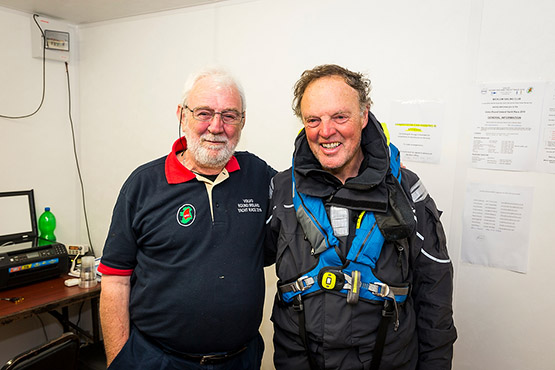
Midnight encounter. Race organiser Theo Phelan with RORC Commodore Michael Boyd after the latter had brought the First 44.7 Lisa across the Wicklow finish line to take third overall. Photo: David Branigan
But that third overall needed a bit of waiting, as the Class 3 front-runners of Euro Car Parks and Rockabill VI were still in with a chance, while Class 4’s GROUPE V and Stephen Quinn’s gallant little J/97 Lambay Rules were also in contention, but it was not to be. The minutes slipped away, the hours ticked by, and in the end over a course of 704 miles it was waterline length which counted as a fading breeze and much windward work saw the little ‘uns lose out. But my word, they had one impressive race amongst themselves.
The results are still being analysed as we write this, and it was only on the Friday that Rambler was finally confirmed as overall winner, with Teasing Machine second and Lisa Third. As for Class winners, they were (1) Teasing Machine, (2) Sarabande, (3) Euro Car Parks, and (4) GROUPE V, but GROUPE V lost her two-handed class lead to Begian Michael Kleinjans’ Open 40 Roaring Forty 2 which was another steady performer.
"All credit to Wicklow Sailing Club’s Theo Phelan and his team"
In all, it was a wonderful race, a magnificent sporting event from which any keen sailor can take much of interest and even more of entertainment and excitement. All credit to Wicklow Sailing Club’s Theo Phelan and his team who have kept this event going through the thin times, and have been ready and waiting to see it come to a new flowering with sponsorship from Volvo Car Ireland.
But all the background organization would have been meaningless without a fleet of boats and their crews game to take on the 704-mile circuit of an island set in an exposed location on the lee side of the Atlantic ocean, and in following this race it has been particularly encouraging to see the improving performances of certain boats as their relatively novice crews get to grips with the challenge they’ve taken on. Needless to say it was also a case of the Old Dog for the Long Road, and Ian Hickey’s Granada 38 Cavatina was again in the frame at the fiish in Class 4.

Top of the class - a notable performance by the sailing school crew from the INSS in Dun Laoghaire. Photo: Afloat.ie
Notably outstanding was the Irish National Sailing School’s Reflex 38 Lynx from Dun Laoghaire, skippered by Kenneth Rumball. She was always in competition, but as the race went on she seemed more in competition than ever, until at the finish she clocked in at fourth among all those hotshots in Class 3, close astern of Conor Fogerty’s Sunfast 3600 Bam at third, and placed tenth overall in fleet. The crew of Lynx have had one excellent lesson in offshore racing.

The essential post-race de-briefing – the crews of Euro Car Parks and Rockabill VI, leaders in Class 3, get together in Wicklow SC on Thursday afternoon after five days of racing against each other round Ireland. Photo: W M Nixon
Volvo Round Ireland 2016 selected results
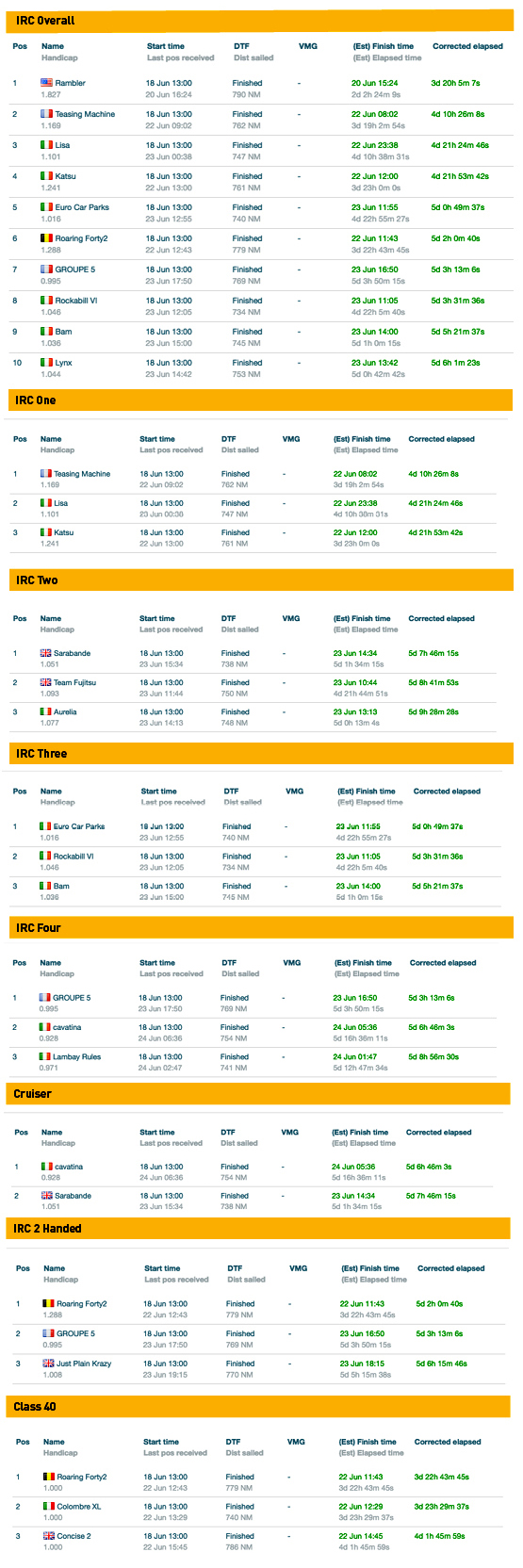
See Round Ireland tracker here Afloat's Round Ireland 2016 coverage is here and download overall results here
#RoundIreland - The 19th Round Ireland Yacht Race got off to a dramatic start from Wicklow at 1pm today. Although American maxi Rambler was prevented from making her spectacular committee boat start by smaller competitors blocking her lane, it was not long before one of the fastest monohulls in the world was streaking ahead of the fleet at Wicklow Head. See start sequence photos of Rambler 88 here.
The committee vessel was lying to the strong south going tide and as the record fleet lined up it was clear the 3–knot tide was bringing them to the line early, too early in some cases.
The large monohull fleet of 52 boats started on time at 1pm but there was a delay starting the multihulls ten minutes later because of an individual recall for boats in the main fleet who had started prematurely. Boats were recalled over the VHF radio by the race committee and were required to start again. Double race winner Cavatina from Royal Cork YC, ironically one of the slowest in the fleet, was one of three boats obliged to restart.
There was some congested waters at the committee boat end of the starting line too as boats clearing the line on starboard tack (including the maxi Rambler) and heading out to sea were confronted by spectator craft in their path.

Adelie (IRL9631) and Euro Car Parks (IRLII41) port tack the fleet at the start of the Round Ireland race 2016
As expected, the three MOD70s multihulls started ten minutes later and streaked ahead soon after the biggest boats in the record–breaking 63–boat fleet passed Wicklow Head.
Shooting @RoundIreland race for @IrishTimes from chopper today #Nikon #Ireland #photography #sailing #roundireland pic.twitter.com/2LU8ygU3Oy
— Eric Luke (@EricLuke2) June 18, 2016
Conditions were as forecast with a light southerly wind of eight to ten knots and south going tide making for one of the first upwind starts in many years.
Fleet bragging rights for the first boat to Wicklow Head was of course Rambler, second was RORC entry Katsu. It was an impressive start under the gaze of hundred of shoreside spectators and a flotilla of boats on the water but as everyone knows, this is not a sprint but a full ocean marathon race of 700–miles duration.
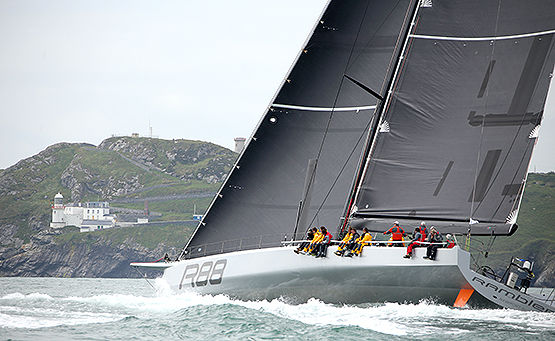
Rambler 88 powers by Wicklow Head
The Navy vessel LE Aisling, as the official starting vessel, sent the fleet on its way. The fastest boats could be back by Monday and a number of Round Ireland records yet could be broken but the overall winner on handicap may not be know till much later in the week, possibly as late as next Friday.
A number of boats hit hit the line at precisely the right moment, aided by a strong tide, prompting some on the shoreline to query just how many boats were over.
As forecast by Afloat.ie's Mike Broughton, a ridge of high pressure over Wicklow brought a light sea breeze off Wicklow Head, and there were near perfect sailing conditions off the Wicklow coast of 8-10-knot winds from the south bright sunshine and a relatively flat sea state.
And they're off! @RoundIreland pic.twitter.com/86PLt11zdf
— Aengus Cox (@AengusCox) June 18, 2016
The 64-boat fleet cleared Wicklow Bay and Wicklow Head Lighthouse under a two-knot ebb tide, pushing them down along the Wexford coastline.
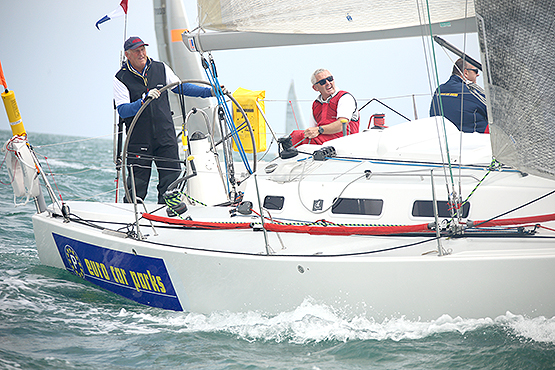
J109 Euro Car Parks steered by Olympian Mark Mansfield, one of 63 boats in today's Round Ireland fleet
However, as forecast, the fleet are expected to have stronger winds tonight as they approach Tuskar Rock. South westerly winds increasing 12-17 knots by early evening, giving a beat south towards Tuskar Rock. Then we have unsettled conditions from midnight as the first of possibly seven fronts to pass the fleet over the next four days. The first warm front will bring light rain and SW winds of 9-15 knots – still giving a beat along the south coast.
The 700-mile race is anticipated to take up to five days to complete, with the biggest boats expected home sometime on Monday.
Follow our race updates all in one handy link here
Read WM Nixon's Round Ireland Race 2016 Preview
'Tough & Challenging Round Ireland Race Ahead', Says Sailing Forecaster Mike Broughton
Specialist sailing weather forecaster Mike Broughton of winningwind.com says tomorrow's Round Ireland Race will be a tough and challenging one
‘Looks like we have light sea breezes for the start in fine and sunny conditions – but it’s all going to change.
For start time we have a ridge of high pressure over Wicklow bringing a light sea breeze that will veer to south westerly winds increasing 12-17 knots by early evening, giving a beat south towards Tuskar Rock. Then we have unsettled conditions from midnight as the first of possibly seven fronts to pass the fleet over the next four days. The first warm front will bring light rain and SW winds of 9-15 knots – still giving a beat along the south coast.
By Sunday afternoon, we have a complex, mid Atlantic low pressure system that will dominate the weather from Sunday to Tuesday, bringing several fronts, with rain and winds to gale force mainly from the south west to west-south-west. It looks like a tough and challenging beat on Sunday afternoon/evening around the Fastnet area, particularly for the smaller boats. We can expect winds to 40 knots and seas 3.5 to 4.0 metres.
The low pressure looks to deepen through Sunday and by midnight is forecast to be 300 miles south of Iceland and will then start to slowly fill. Leaving most of the fleet in WSW winds along the west coast on Monday morning, giving fast reaching conditions north, still in waves around 3.5 metres. Winds for Monday afternoon to Tuesday evening still look to be strong (mainly 24-34 knots) from the WSW and giving fast broad reaching conditions across the north coast. Whilst winds on the NE coast will be lighter in the lee of the mainland. Winds east of Dublin will be down to 10 knots by Thursday – mainly from WSW to SW.
Overall, it looks like a tough and challenging race, with plenty of opportunities to make gains from the predictable shifts from passing fronts. Rough seas close to the Fastnet and all along the west coast.
Best of luck to my many friends out there doing the race – it will be one to remember!
New Round Ireland Records Top Of The Agenda At Wicklow Today
Today sees the start off the Wicklow Pierheads of largest and most varied fleet in the 36-year history of the biennial Round Ireland Race from, which in its 19th edition takes on board sponsors Volvo Car Ireland for the first time. The fleet ranges in size from a trio of boats around the 31ft to 32ft band, right up to the 88ft–Rambler, with the three exceptional trimarans of the MOD 70 class next in size. But while attention will inevitably focus on the super-machines at the top end of the fleet, many of those taking part are club sailors from Ireland and overseas, racing standard craft which have only been modified where necessary to comply with the strict R0RC regulations which a race of this calibre requires. As well, the re-birth of local offshore racing in Irish waters is well-reflected with the presence of boats which have been giving a very good showing of themselves in weekend passage races, while boats which performed well in both last year’s Dun Laoghaire to Dingle Race in June and the Rolex Fastnet Race 2015 in August are also very much in contention. W M Nixon gives his take on the mood of the moment, and shares a few pointers for possible top performers.
The international sailing superstars who have come here for the Volvo Round Ireland Race will have experienced many kinds of sailing weather - much of it glamorously and spectacularly sunny stuff - during their hectic careers afloat. But by the time the super-fast leaders are approaching the Wicklow finish line in the early days of next week, they’ll have been able to savour just about everything the Irish climate throws at us, summer and winter……
With most of the top boats assembling as pre-arranged within the ambit of the Royal Irish Yacht Club through this past week, they’ll have shared with the Irish people an almost freakish drop in the temperature as the low pressure area over England, which was in turn sending even worse weather into France for the European Football Cup, began to bring to us here in the Emerald Isle a wet and windy northerly airstream of quite remarkable coldness.
Thursday June 16th – Bloomsday by happy accident – was selected for the evening in which we all could get to know the legends of sailing at an evening reception at the Royal Irish. When the date was being set, you can so easily imagine the organisers visualising a balmy summer evening, with the scene augmented by the DBSC fleet returning to port from their regular Thursday fixture, while on the waterfront terrace of the elegant old yacht club, people could stroll in their summer finery – perhaps we’d even have a Bloomsday veteran or two still properly garbed – and it would be just such a perfect June evening.
But things happened otherwise. Within the already cold northerly airstream, through Thursday a small but always measurable balloon of hyper-cold air between 9 and 11 degrees appeared at the north end of Ireland’s east coast. It spent the day moving southward, remaining remarkably intact in size, and by party time on Thursday at the RIYC it was sitting plumb over Dun Laoghaire, with the temperature at its cold heart now persistently down at 9 degrees.
One of the favourites. Alan Hannon’s clean-lined Reichel-Pugh 45 Katsu in Dun Laoghaire on Thursday evening. Photo: W M Nixon
But anyone who reckons that such a situation would be the ultimate party pooper just doesn’t get it with the kind of people who do the round Ireland, and particularly those who come a long way to take part. They had themselves a ball, they had themselves a blast, and there more were twists and turns to the potential of the Dun Laoghaire-Dublin setup that even the locals would now of.
For instance Brian Thompson, sailing master of Lloyd Thornburg’s all-conquering MOD 70 Phaedo 3, is up to speed on matters Irish, having been a crew-member when Steve Fossett’s 60ft trimaran Lakota established the Ireland circuit record of 1993 which stood for 22 years. So on Thursday night when he heard it was Bloomsday and that that Joyce’s Portrait of the Artist As A Young Man was on at the Pavilion Theatre just across the road, he showed his face for just long enough to be polite at the party in the yacht club, and then skedaddled across the road for a night of high culture.
Meanwhile, RORC Commodore and longtime RIYC member Michael Boyd was settling in very well in the midst of this throng in his home club, working the room and savouring the moment, for nearby on the pontoon was the First 44.7 Lisa which he’ll be skippering round Ireland. He already won the race in 1996 with the J/35 Big Ears, but for the 2016 race he definitely has the more comfortable boat with all mod cons.
The Volvo Round Ireland fleet in stopover mode at the Royal Irish YC in Dun Laoghaire. In the foreground are Michael Boyd’s First 44.7 Lisa, and Paul O’Higgins’ JPK 10.80 Rockabill VI. Photo: W M Nixon
So when it was mentioned that the start of the race at Wicklow is exquisitely timed to exactly match the kick-off in the European Cup’s Ireland-Belgium match in Bordeaux, it didn’t take a feather out of the Commodore, as he cheerfully accepting that the first two hours of the race would be a little slow for Lisa “because only the helmsman will be on deck, the rest of us will be below watching the match”.
His brother Paddy, home from Canada and almost straight into the Round Ireland, will be sailing with Michael together with a formidable crew which incudes the likes of Barry Hurley and Tim Greenwood, so with Lisa well in the frame in the RORC points table, we can be sure that the points weighting of 1.4 which the Round Ireland provides will be treated with the seriousness it deserves.
Nevertheless the idea of watching football matches on a yacht in mid-race just wouldn’t go away, and Paddy recalled the race of 1994 which he did with Mark Mansfield as skipper aboard Brian Buchanan’s Frers 49 Hesperia (overall winner in 1988 with Dickie Gomes as skipper), the boat having become AIB for the duration of the race.
As it happened, that duration wasn’t very long. On the Saturday night they were pacing nicely with Moonduster with the Tuskar astern, both boats turning pleasantly to windward in classic Frers style in abut 15 knots of wind, and all well with the world with the watch off duty (and some of the watch on duty) glued to a little screen in the saloon, where Ireland could be seen playing Italy in the World Cup in the US.
Ireland scored a goal…... From the depths of AIB/Hesperia’s saloon, there erupted a mighty road of approval. And the mast fell down. Just like that. For no clear reason. This has led Paddy to develop a theory that just as an opera singer can shatter a wine glass with a particularly note, so the wild shout of Irish approval for a goal score can bring down a perfectly-tuned mast.
When you’re getting theories like that being learnedly discussed, you get the gist of the party, but there was much more to it than that. Every so often a blast of cold air would erupt into the clubhouse as some new international crew from some boat of legend swept into the party, and I have to tell you that top modern sailors are getting very tall. Not beanpole tall, either. Just big strong tall – maybe they have special breeding programmes to improve the line in France and the US, which is where most of them seem to have originated.
Thus it says much about the size and presence of George David of Rambler 88 that he still stood out in the midst of this crowd of sailing giants in the rather august setting of the RIYC’s stately rooms. He is some piece of work. It’s unlikely he’ll ever apply for the free bus pass for which he qualified a year or two ago, but if Wall Street was ever blown away, he could turn a bob or two as a stand-up comedian. Another option would be a writing a book abut his personal fitness regime, if he has one, for although he’s a big fellow he moves with the grace and ease of someone half his age. And while he’s at that stage in life when most us look at the world through a network of veins, his eyes are as clear as an Optrex ad.
Modern building, very modern boat – Rambler 88 in her Dun Laoghaire berth at the Ferry Terminal. Photo: W M Nixon

George David, owner-skipper of Rambler 88
As to the business of Rambler 88 breaking the Leopard (Mike Slade) Round Ireland course record of 65 hours from 2008, George David reckons it’s very much on the cards. 2008 was a messy race, with more wind than was useful, and Leopard’s average was only 10.8 knots. But for 2016, Rambler’s skipper figures that if they can make a reasonably efficient job of the uphill sailing to get to the Fastnet, they’ll be looking to average 25 knots along the western seaboard and north coast in strong sou’west to west breezes, and there’s even a chance than once they get near the Irish Sea, the wind will have veered a little more to give them a slant down to Wicklow.
“In most of our races, we expect an average of 13 to 15 knots, and though this can be a difficult course, it’s looking quite good at the moment”. With the Rambler 88 crew including sailors of the calibre of America’s Cup winning skipper Brad Butterworth and Andrew Cape on board, it is indeed looking good.
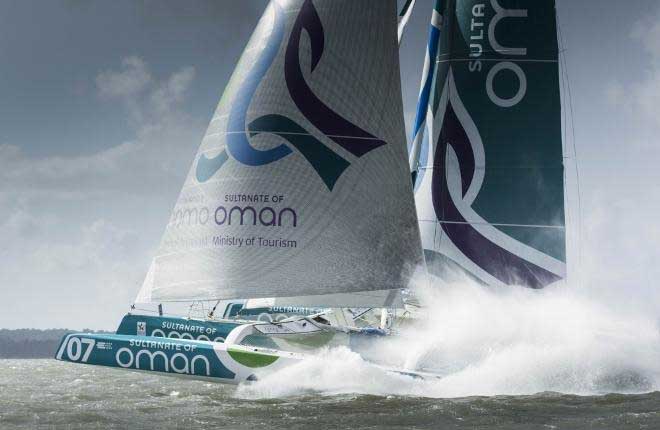
Musandam-Oman in record-breaking form
While Rambler is odds-on to be the first mono-hull to finish, it’s highly likely the oldest boat in the race, the beautifully-restored 43ft Tyrrell ketch of 1937 vintage, Darryl Hughes’ Maybird, will finish last on the water. He found himself in Dun Laoghaire marina berthed just ahead of Sidney Gavignet’s MOD 70 Musandam-Oman, and in the whirl of people up in the clubhouse, the Number One aboard Musandam, Derrynane’s favorite sailor Damian Foxall was relaxed in one of those constantly changing groups which at one stage included Darryl Hughes and northern sailing journalist Betty Armstrong, who is one of the few sailing journalists who has ever actually helmed a MOD 70.
Maybird looking tiny amongst assorted exotica in Dun Laoghaire Marina on Thursday evening. Yet once upon a time in the late 1940s, her sister-ship Aideen (below right) was one of the biggest yachts about the place.

Normally journos are padded up with safety gear like a sack of potatoes on the Mod 70s, for as we learned when one of them capsized in Dublin Bay in 2012, they’re so wide it’s dangerous to fall off them (the MOD 70s, that is…). But out in Valencia, when Betty was the journalist on board Musandam Oman for an inshore race, and she’d found herself a safe spot on the forward netting. Bur there was a straightforward sail back to the harbour, and Damian made his way forward and asked her back to the cockpit, and when she was there, he asked her would she like to helm: “There’s nothing to it”, said he.
So there was Mrs Armstrong of Bangor in County Down helming this wonderful machine at a very smooth 25–knots, and as she says: “Do you know what, there really was nothing to it. The boat was going so smoothly and there was so little feel in the helm that it was only the speedometer which could persuade me I was steering a sailing boat at 25 knots”.
In today’s Volvo Round Ireland 2016 race. they’ll be expecting more than 25 knots and conditions way beyond the “very smooth” once the big multihulls get the Fastnet astern and start to get a bit of north in their course. The weather pattern has moved on a bit from the conditions we were anticipating here on Wednesday, when there was talk of nor’easters at the start giving way to sou’westers by tonight. It now looks as though the ridge which was expected to cross Ireland during today will be slightly earlier than expected, and losing strength in its push to the northeast, thus at start time the underlying wind at Wicklow will be a slack nor’wester
Very soon, however, the weather will be dominated by a big wet low out in the Atlantic, though some comfort can be taken from the fact that pressure won’t become excessively low over Ireland. But the isobars will be close enough together to provide freshening breezes, and well before midnight tonight, the sou’westers will be established at the Tuskar, becoming strong during tomorrow all along the South and West coasts.
Thus getting to the turn in the Fastnet Rock/Mizen Head area is crucial (as it always is), but this year it’s especially the case. And of course while the MOD 70s and Rambler will be looking to have it ticked off well before noon tomorrow, anything much smaller will inevitably be facing a slugging match all the way from somehere north of the Tuskar Rock right down to Ireland’s great southwest capes.
BOATS TO WATCH
With a fleet of 64 boats, it’s impossible to give a complete form guide, so we’ll take ten from the body of the fleet which provide the winning combination of good all-round boats with able crew:
KATSOU (Alan Hannon, RORC & RUYC) This Reichel-Pugh 45 attracted much favourable interested in one of the premier berths at the RIYC on Thursday night, and rightly so. She comes with a good track record, and for this race she has a formidable crew built around the very best of the northwest from Lough Swilly YC, with Richie Fearon navigating (he navigated the winner Tanit in 2014) the winning Clipper Race Skipper Sean McCarter (he also was awarded the Cruising Club of America Rod Stephens Trophy for seamanship last year after successfully dealing with a man overboard in the North Pacific), and also Diarmaid MacAuley, one of the north’s best offshore helms.
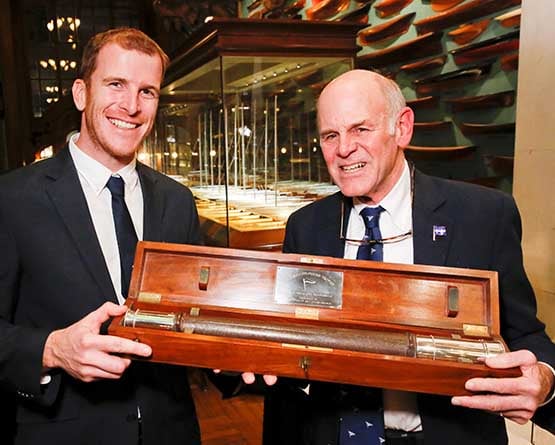
Sean McCarter of Lough Swilly YC receives the Cruising Club of America Roderick Stephens Award from CCA Commodore Tad Lhamon in New York, March 2015. McCarter will be sailing on Katsu during the Volvo Round Ireland Race
LISA (Michael Boyd, RORC & RYC). RORC Commodore Boyd has form in the round Ireland, he won in 1986, and Lisa certainly has form this year in beingin the frame in the RORC Championship. A First 44.7, she should cope well with the expected conditions.
EURO CAR PARKS (Dave Cullen, HYC). Also known as the Kelly family’s J/109 Storm, she has been chartered for this race by World Half Ton Classics Champion Dave Cullen and he has assembled a crew of six champions (himself included) from last weekends ICRA Nats. When you’ve the likes of Mark Mansfield, Maurice “Prof” O’Connell and Johnny Murphy sharing boat space, then good results are expected.
MOJITO (Peter Dunlop & Vicky Cox, Pwllheli SC) They’d a good second in last year’s Dun Laoghaire to Dingle Race, they’re one of the most consistent J/109s around, and they draw their crew from both sides of the Irish Sea in the best traditions of ISORA.
ROCKABILL VI (Paul O’Higgins, RIYC). Still something of an unknown force in her own right, Rockabill VI has the flawless pedigree of being a JPK 10.80 (Fastnet Race winner, Hobart Race class winner etc etc), so as they settle in the O’Higgins crew should move up the rankings
TEASING MACHINE (Eric de Turckheim, France). One of the world’s most sporting offshore racers, this 13m Archambault hs a go at everything from the Commodore’s Cup to the Sydney-Hobart, with a Fastnet thrown in for good measure. She’s always in the frame, she’s an amazing boat, and she and her crew will give of their best.
DESPERADO OF COWES (Richard Loftus, RYS) This vintage Swan 65 would be a good heavy weather selection. And she has a surprisingly competitive rating. She’ll be able to keep going with her crew in relative comfort while smaller craft are bouncing around with crew fatigue becoming a major problem.
AURELIA (Chris & Patanne Power Smith, RStGYC). The Power Smith’s J/122 is the Steady Eddy of the Dun Laoghaire fleet. She was the top-placed non-J/109 in last year’s Dun Laoghaire-Dingle in a race which might have been designed with the J/109 in mind, she has already won ISORA’s biggest race this year, and in all she is a boat which exudes competence.
BAM! (Conor Fogerty, HYC) Athough the Sunfast 3600 Bam! won her class in the RORC Caribbean 600 in February, with her owner subsequently sailing her single-handed from the Caribbean to the Azores when homeward bound, she is not a boat which is suited to the restrictive Irish Sea courses. But the wide open spaces of the Atlantic with winds abaft the beam will enable her to fly – it’s just getting down to the Fastnet that will be the hard bit.
CAVATINA (Ian Hickey, RCYC) The veteran Noray 38 Cavatina is the multiple Round Ireland winner most associated with Eric Lisson, but with her low rating and renowned staying power, if a flat patch happens to slow the whole fleet back, she’s always there, ready to pounce. While it seems unlikely this year, people have got Cavatina’s results prediction wrong before now.
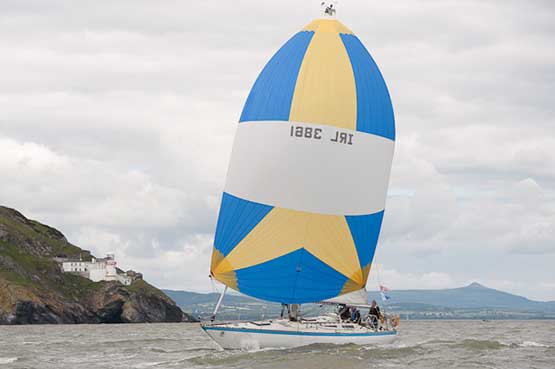
Ian Hickey’s Cavatina (RCYC) off Wicklow Head. She probably holds the record for most Round Ireland races sailed
The Volvo Round Ireland Race 2016 with its record fleet has the task of prediction made more complicated by the many sub-divisions, one of the busiest being the Open 40 Class which is within IRC, yet also races on its own, and for good measure some of the boats are fully-crewed while others are in the Two-Handed Division.
One of the most interesting of the latter is Roaring Forty 2, doing this race as Visit Brussels under the command of Belgian skipper Michael Kleinjans, who also happens to be the holder of the Round Ireland Single-Handed Record, which you can’t really compete for any more, as single-handed record sailing is now officially illegal in Irish waters. But it may well be that Kleinjans and his crew Ian Wittevrongel will set a two-handed Round Ireland Record in this race which will be worthy of future attention.
 Michael Kleinjens’ Open 40 Visit Brussels will be a favourite for line honours in the two-handed division. She is seen here zapping between two Figaro Solos
Michael Kleinjens’ Open 40 Visit Brussels will be a favourite for line honours in the two-handed division. She is seen here zapping between two Figaro Solos
Meanwhile, we’ll be carrying regular updates and comment on Afloat,ie HERE as the race progresses, based on the Race Tracker. We very much hope that by the time the time the prize-giving comes round in Wicklow on Friday evening, we’ll have mentioned every boat in the fleet at least once. But now, after partying on Thursday night (and a very good party it was too), there’s work to be done today, both off Wicklow and southward down the coast.
And in the end, it will all be in honour of the memory of the great Denis Doyle and his crew for their beautiful 1984 win and course record.
Denis Doyle and his crew aboard Moonduster after their great win in 1984. This photo was taken through glass in Wicklow SC, where it is on display in the Round Ireland Room. Has anyone any idea where the original neg might be sourced?
88–Foot American Maxi Yacht Is Just Too Big To Berth At Royal Irish YC & Dun Laoghaire Marina
Following its arrival into Dun Laoghaire on Monday evening, maxi Round Ireland race entry Rambler 88 has been moored on St. Michael's Wharf, close to the Royal St. George Yacht Club in Dun Laoghaire Harbour. The special berth was arranged because the 23–tonne yacht's keel is nearly 20–feet deep, meaning she is just too big to go alongside the Dublin hosts at the Royal Irish Yacht Club or the town marina, both of which are currently catering for nearly half of the 65–boat Round Ireland fleet.
The boat is owned by American businessman George David, who made headlines off the Irish coast five years ago when an earlier boat Rambler 100 capsized off the Fastnet rock in August 2011.
His new boat has a powerful hull shape with a giant chine running the full extent of the hull and similarly a hull-deck chamfer running the length of the hull, it also has a substantial bowsprit. The boat has a canting keel and there is a VO70-style cuddy over the companionway. Her all carbon 135-foot mast can be seen from afar, towering over other yachts in the harbour.
Rambler 88's results last season included; Voiles de St Barths – overall winner, RORC Caribbean 600 – line honours winner (3rd overall), Rolex Middle Sea Race – line honours winner (7th overall) and the Rolex Sydney-Hobart – 3rd over the line.
According to website, The Daily Sail, The 88–ft long boat is too big to be called a 'Mini Maxi' and is also not a maximum length 'maxi' (ie 100ft) either.
The exotic yacht that has competed all over the world, has already drawn many admiring glances from local boats competing in last night's DBSC races.
Dimensions
LOA 27.00m/88ft 7in
Beam 7.10m/23ft 4in
Draught 6.00m/19ft 8in
Mast height 41.47m/135ft 10in
Displacement
(lightship) 22,890kg/50,463lb
Sail area:
upwind 512/638m2/5,511/6,687ft2
downwind 980m2/10,548ft2
mainsail 318m2/4,423ft2
IRC rating 1.88
Designed by Juan Kouyoumdjian Yacht Design
Built by New England Boatworks, RI, USA
Mast/boom Southern Spars
More on this extraordinary boat from Yachting World here
Round Ireland Racer Phaedo3 Takes a Spin on Dublin Bay
Volvo Round Ireland racer Phaedo3 went for a tack on Dublin Bay yesterday, making short work of a trip out past Dalkey Island as Saturday's DMYC 'King of the Bay' regatta was underway.
US sailor, Lloyd Thornburg brought his MOD 70 Phaedo 3 into Dun Laoghaire Harbour in advance of next Saturday's Round Ireland Yacht Race start off Wicklow. Phaedo3 arrives in Irish waters following an incredibly successful run of world records and regatta wins. The world-famous superfast multihull, capable of speeds in excess of 40 knots, has already set multiple speed records on the international circuit. Double Volvo Ocean Race winner Justin Slattery will join Thornburg for the Irish classic. The 70–footer has undergone a new paint job for the Irish race.
An early arrival for the 704-mile Volvo Round Ireland race arrived under bare poles and engine into Dublin Bay this morning, eight days ahead of the start off Wicklow on Saturday, June 18th.
US sailor, Lloyd Thornburg brought his MOD 70 Phaedo 3 into Dun Laoghaire Harbour this morning following an incredibly successful run of world records and regatta wins. The world-famous superfast multihull, capable of speeds in excess of 40 knots, has already set multiple speed records on the international circuit. Double Volvo Ocean Race winner Justin Slattery will join Thornburg for the Irish classic. The 70–footer has undergone a new paint job for the Irish race.
In addition, the Sultanate of Oman is sending its flagship trimaran, the Mod 70 Musandam-Oman Sail, to compete in this year’s race and Kerry offshore champ Damian Foxall will be on board. A third trimaran the Mod 70 Concise Ten from the UK is also contesting the race, the biggest ever race since the Round Ireland was founded in 1980 with a record 65 entrants from small private sailing boats right up to the massive trimarans.



























